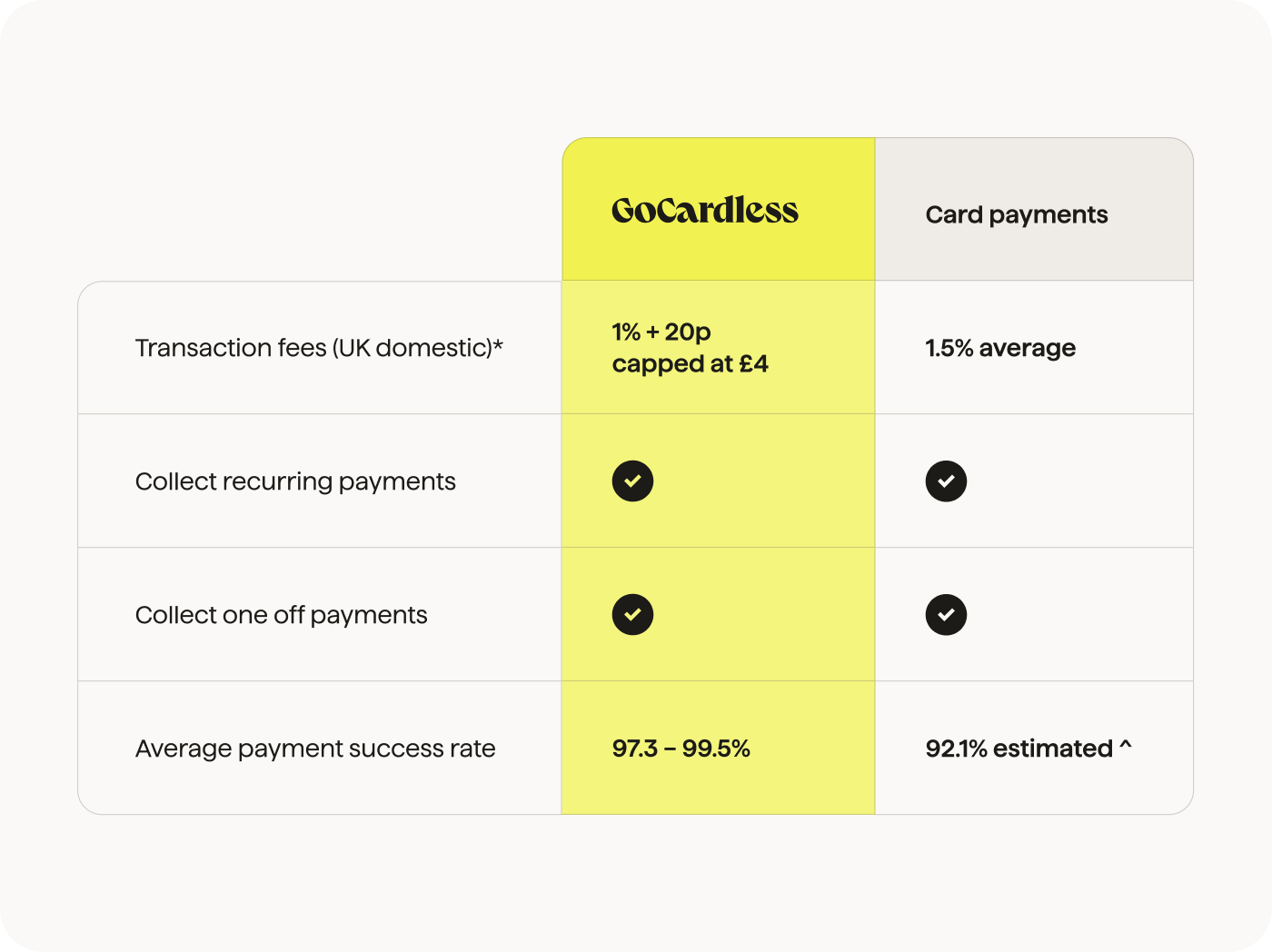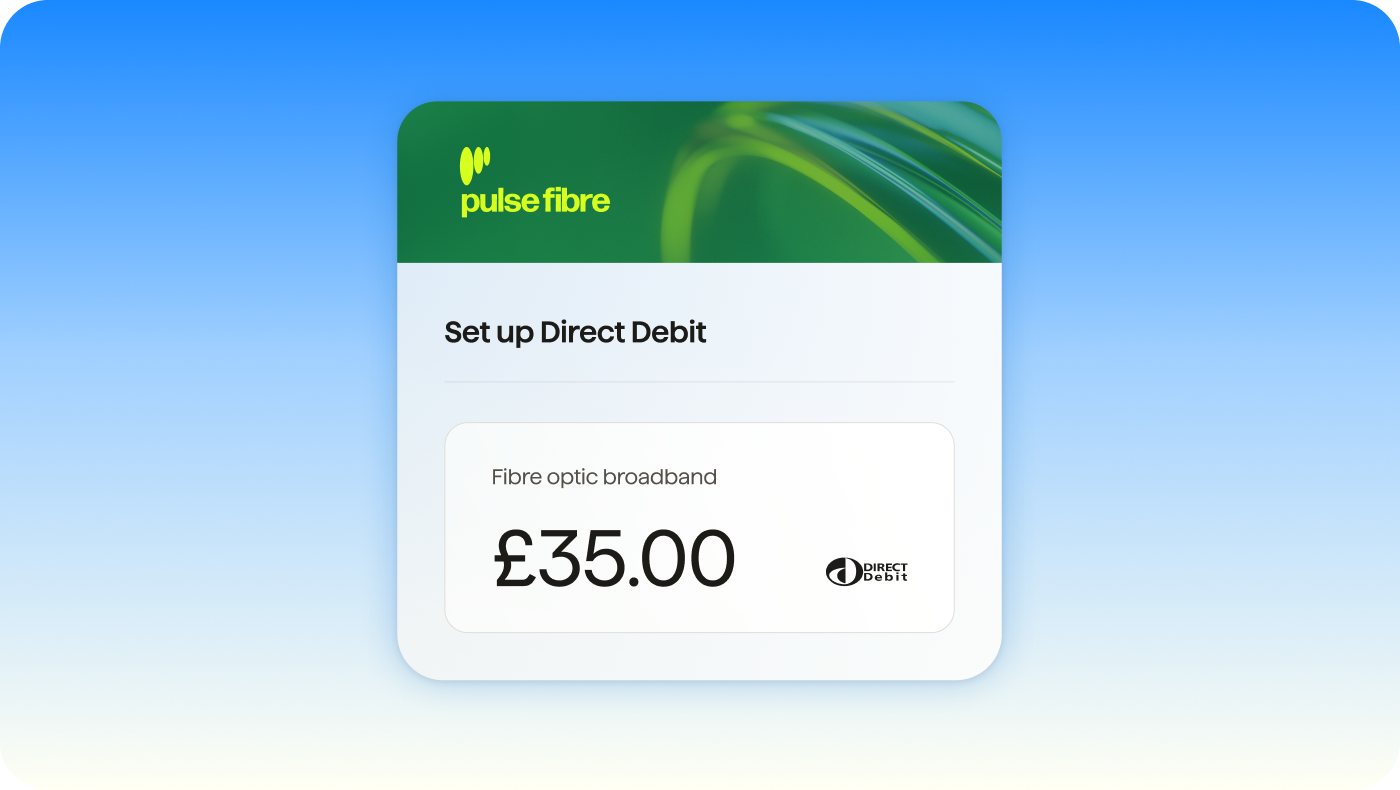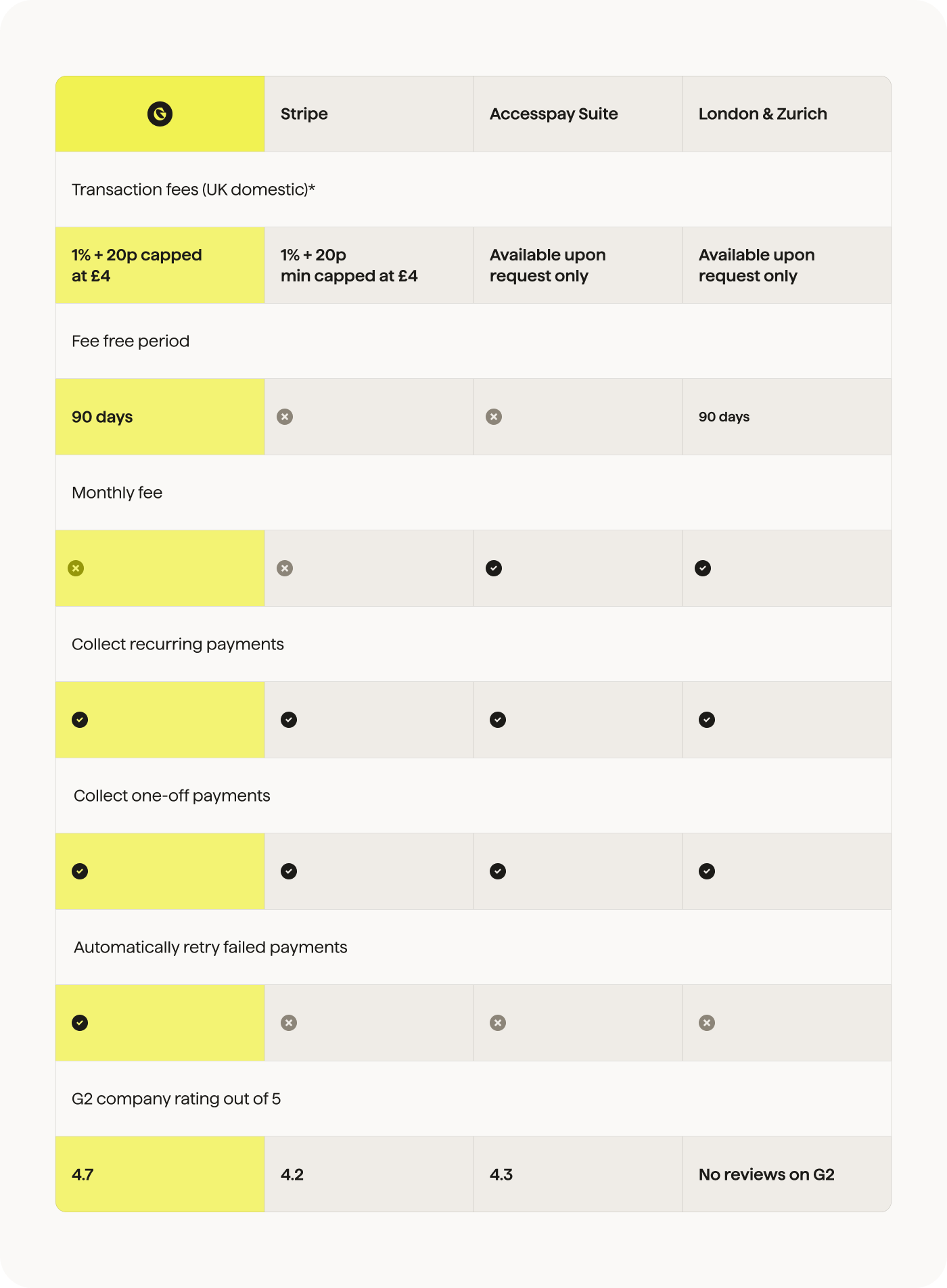Last editedOct 20257 min read
Direct Debit vs credit card: recurring payments can be collected with credit or debit cards, through Continuous Payment Authority (or continuous card payments), or through Direct Debit, which is a direct account-to-account bank payment. Although both enable you to take and manage payments easily, there are some important differences.
Direct Debit vs card payment

* Pricing as of Aug 2025. Fees differ by provider. ^ Based on market research. Payment success rates vary.
Direct Debit and credit or debit cards are two of the most common methods used for taking regular, recurring payments.
Both are automatic payment methods that enable you to easily take and manage payments from thousands of customers, but you should be aware of some important differences.
Direct Debit is a direct account-to-account bank payment that was specifically designed to be able to collect recurring payments in a flexible way, while Continuous Payment Authority, the mechanism for setting up recurring card payments, is one use-case of wider credit and debit card functionality.
This guide gives you a comparison of Direct Debit vs Continuous Payment Authority for recurring card payments to help you decide which might work best for your business.
Let’s look at the details of each method:
Continuous Payment Authority (CPA) for recurring card payments
A Continuous Payment Authority (CPA) is an authorisation given by a customer for you to take payments from them by credit or debit card. These payments can vary in frequency and amount.
Other names for CPA include:
recurring transactions
continuous card payments
recurring payments
continuous authority transactions
guaranteed payments
CPA payments are taken by credit or debit card. Customers must supply you with their 16-digit card number, which is then linked to your bank account by the card networks and settlement banks.
Direct Debit for recurring payments
A Direct Debit is an authorisation from a customer that enables you to take payments from their bank account. These payments can also vary in frequency and amount.
Direct Debit payments are taken directly from your customer’s bank account. Customers sign up for the Direct Debit using their bank account number and sort code.
Direct Debit vs card payment

Collecting recurring payments by Direct Debit or Continuous Payment Authority has significant differences; we look at the following metrics to help you understand which recurring payment method fits your business requirements more.
Ease of set up
Level of flexibility
Costs of transactions
Payment timings
Payment failure rates
Level of manual admin
Security & customer protections
How to collect Direct Debit payments with GoCardless
1.
Create your free GoCardless account, access your user-friendly payments dashboard & connect your accounting software (if you use one).
2.
Easily set up & schedule Direct Debit payments via payment pages on your website checkout or secure payment links.
3.
From now on you'll get paid on time, every time, as GoCardless automatically collects payment on the scheduled Direct Debit collection date. Simple.
Set-up and flexibility
Recurring card payment set up - A combination of a merchant account, payment processor and payment gateway is required to accept card payments. The providers you choose will depend on your business and the volume of transactions you expect.
To set up CPA payments, you will be able set the payment dates and amounts as needed using your provider's user interface and send your client a link to complete the authorisation.
Direct Debit set up – As with cards, you will need a provider to accept Direct Debit payments. GoCardless provides a cost-effective Direct Debit collection service with an easy-to-use online dashboard through which you can easily set up payments in just a few clicks. Direct Debit via GoCardless allows you to choose the date, frequency and payment amount.
Direct Debit offers a high degree of flexibility, meaning you can change the due date, the frequency and the amount without further permission from the client. When you adjust your Direct Debit, GoCardless will notify your client on your behalf, leaving you to focus on your business.
Costs: set up and transaction fees
Costs of recurring card payment - the costs for accepting credit and debit card payments vary widely, depending on a number of factors, including:
fee structure of your payment gateway/merchant account/payment processor
your usage volume
location of the payer
payers card network
You can collect recurring payments internationally through CPA, although there will likely be significant additional fees for cross-border transactions, so check with your card payment provider.
Typically, using card networks to collect recurring payments is more expensive than using bank payment methods like Direct Debit due to the number of intermediaries involved in the process - each adding a fee to the cost of transactions.
Costs of Direct Debit - as a direct account-to-account bank payment, Direct Debit offers a much more cost-effective option for collecting recurring payments.
Unlike collecting via cards with Direct Debit, transaction fees are more cost-effective and predictable. Not only is Direct Debit through GoCardless cheaper than collecting via cards, but we also provide pricing transparency.
Accepting a £500 payment via credit or debit card will cost a merchant between £7.50 and £15.
However, with GoCardless, that transaction costs significantly less - click here for full pricing information.
Quick overview

* Pricing as of July 2025. Plans vary.
GoCardless can also facilitate seamless cross-border payments in over 30 countries using local payment schemes, including the US, the EU, the Nordics, Australia, and New Zealand.
Research has shown that being able to offer local payment methods familiar to prospects in those countries, such as ACH in the US, SEPA Direct Debit in the EU, and BECs Direct Debit in Australia, typically increases sales in international locales.
With GoCardless, as well as low transaction fees, it’s free to get set up, and there is no contract or upfront commitment required. Learn more about how Direct Debit via GoCardless is the best way to collect payments.
Speed - payment timings
Recurring card payment timings - like many aspects of collecting card payments, timings vary depending on the card issuer and payment provider. However, in general, card payments are fast and will clear in the receiving account within 24 hours, making next-day payments a strong likelihood.
Direct Debit timings - Direct Debit has many advantages, but the speed of payment timings is not one of them. Direct Debit transactions will take 3 - 5 days for funds to be available, which makes it an unsuitable payment method for businesses requiring same or next-day payment.
For businesses that want all the advantages of Direct Debit but also require an initial instant payment, GoCardless offers a seamless combination of Instant Bank Pay and Direct Debit.
Using this combination, businesses can set up a recurring Direct Debit payment and, at the same time, take an initial instant payment through our Instant Bank Pay functionality.
Payment failure vs success rate
Recurring card payment failure rate - whether it is a customer's credit card or debit card your business is collecting from, you will experience a frustrating level of payment failure!
Indeed, on average, card payments fail at a rate of between 10 - 15% across the board.
Of course, any payment can fail due to a temporary glitch or technical issue, but the main reason for the high failure rate of card payments is that every debit and credit card will eventually either:
be lost
be cancelled
or expire
The result is customer churn - the involuntary loss of customers due to lost, cancelled or expired cards. These are people who would have happily remained as paying customers, but research shows that most of them will not sign up again.
Direct Debit success rate - Direct Debit is paid directly from customer bank accounts and as bank accounts do not become lost, get cancelled or expire, businesses collecting using this method enjoy much higher payment success rates.
GoCardless, collects payments for 85,000 businesses, with an average failure rate of just 2.9% - that means that 97.3% of payments are collected successfully on the first attempt.
With the intelligent retry product Success+, the GoCardless payment success rate increases to 99.1% of all payments collected successfully.
Automating payment collection with Direct Debit via GoCardless is more affordable, more secure and more reliable than accepting credit and debit card payments.
Admin requirements
Recurring card payment admin - card payments require a certain level of admin. Exactly how much will depend on your payment provider and how much automation they provide in their user interface.
Failed card payments will generate a lot of manual admin as customers will need chasing up to resubmit their card details and backdate any outstanding payments. Payments will still need to be reconciled, which can be a time-consuming manual process.
Direct Debit admin - high success rates naturally reduce the level of manual admin required to be completed by finance teams.
GoCardless integrates with over 200 accounting software packages, allowing a high level of automation, and reducing the need for manual admin. With GoCardless integrations, bank reconciliation can also be automated, making Direct Debit a real time-saver when it comes to payment and accounting admin.
Security & customer protection
Recurring card payment security - cards are more susceptible to fraud and abuse. Indeed, credit card fraud is becoming more of a serious consideration when it comes to weighing payment methods after Experien reported that the rate of credit card fraud in the UK jumped to a five-year high!
In terms of protection, cardholders can request chargebacks when using a credit card, as the funds are paid from the card issuer's account. For debit cards, however, the funds are debited directly from the customer account, limiting the consumer protections available.
Direct Debit protection - Direct Debit is typically less susceptible to fraud than credit and debit cards. The Direct Debit Guarantee also offers strong consumer protections, making any unauthorised withdrawal refundable. This protection gives customers peace of mind and counteracts any objections to paying by Direct Debit.
Watch the video to learn about Direct Debit in a nutshell:
Automating payment collection with Direct Debit via GoCardless is more affordable, more secure and more reliable than accepting credit and debit card payments.
Continuous Payment Authority vs Direct Debit
Here’s a comparison table for CPA and recurring bank payments:
| CPA | Direct Debit | |
|---|---|---|
| Set up | Customers sign up using their credit or debit card number by phone, online or in person. | Customers complete a Direct Debit Mandate form online, by paper or over the phone using their bank account number and sort code. |
| Cost per payment | High. Typically around 3% + 20p per payment plus a monthly fee for a merchant account. | Low. Depends on your provider. (See our pricing) |
| Failure rates | High. c. 5% due to credit card expiry and cancellation. | Very low. < 1% with GoCardless. This is much better for customer retention. |
| Flexibility of payments | High. You can collect variable amounts or change the amount or date of payments without asking customers for further authorisation | High. You can collect variable amounts or change the amount or date of payments without asking customers for further authorisation. |
| Risk of late payment | Low. You can charge customers when the payment is due. | Low. You can charge customers when a payment is due. |
| Admin required | Mid. You will need to chase customers to update their details when cards expire or are cancelled. Expect this to happen at least every 3 years per customer. | Low. Uses bank details which rarely expire or are cancelled so churn is much lower. |
| Customer protection | Medium. Chargebacks are possible with credit cards. | High. Immediate refunds from your bank with no time limit in the event of an incorrect charge. |
Should I use CPA or Direct Debit?
CPAs and Direct Debit can both be used for recurring payments, including those which vary in amount and frequency.
CPAs offer many similar benefits to Direct Debit but suffer from higher failure rates due to card expiry and cancellation. This is a bad experience for your customers. It creates unnecessary work for them to have to update their details, and they may even decide to let their payments lapse to avoid the hassle. By contrast, Direct Debit payments use a customer’s bank details, which never expire and rarely change.
Furthermore, with fraud on the rise, bank payment methods like Direct Debit offer a higher level of security and stronger consumer protections.
Some businesses have previously had to balance the advantages of lower transaction fees, higher security and higher payment success rates of Direct Debit with the need for funds to clear the next day.
However, with GoCardless now offering seamless integration of Direct Debit with Instant Bank Pay that is no longer a barrier to accessing all the advantages of collecting recurring payments through Direct debit.
Case study - from cards to Direct Debit & Instant Bank Pay
Big Blu, a satellite internet provider, was collecting Direct Debit via their bank and also accepted card payments via CPA. Their payment collection methods were costing them too much time and money dealing with a high burden of bank admin, as well as chasing failed CPA payments.
Switching to GoCardless in order to automate Direct Debit collection and phase out cards with their high failure rate has resulted in a time saving of two hours a day automating payment collection and achieved a 97% - 98% success rate collecting payments across all territories.
“Between 99% and 100% of our payments go through GoCardless today, which has saved us a huge amount of time and money. Our monthly accounts used to take three weeks to put together – now it’s about five days and the team can get an up-to-date picture of financial performance at any given time.” - Craig Allen, Head of Billing & Credit Control
Watch the video:
Automating payment collection with Direct Debit via GoCardless is more affordable, more secure and more reliable than accepting credit and debit card payments.
FAQs: Direct Debit vs credit card & debit card
What’s the difference between a Direct Debit and a credit card?
A Direct Debit is a bank payment method where the payer provides authorisation for the payee to pull funds from the payer’s account on dates due.
A credit card is a form of ongoing credit that allows consumers to make purchases both online and offline with the card issuer’s money and repay on an agreed schedule.
Can you pay a Direct Debit with a credit card?
No, you cannot pay a Direct Debit from a credit card. A Direct Debit is a direct account-to-account payment between two UK banks. A Direct Debit payment can only come from a bank account.
Is a Direct Debit linked to a card or an account?
A Direct Debit is a form of recurring payment to a bank account. Direct debit payments are specifically account-to-account transfers between two banks
What are the disadvantages of Direct Debit?
Direct Debit has few disadvantages currently. Historically one drawback was the payment timings for merchants that needed funds to clear the next day.
However, with the advent of Open Banking and the development of payment methods like Instant Bank Pay, GoCardless can offer merchants all the advantages of Direct Debit, seamlessly combined with Instant Bank Pay to meet all your requirements.
Why do companies prefer Direct Debit?
Companies prefer to accept Direct Debit payments because it is easier and more convenient for customers and consumers. Higher payment success rates result in less manual admin, making payment administration less onerous and allowing the business to focus on customer service rather than payment collection.
Payment data shows that customers who pay by Direct Debit are retained as customers longer than those using credit and debit cards.

